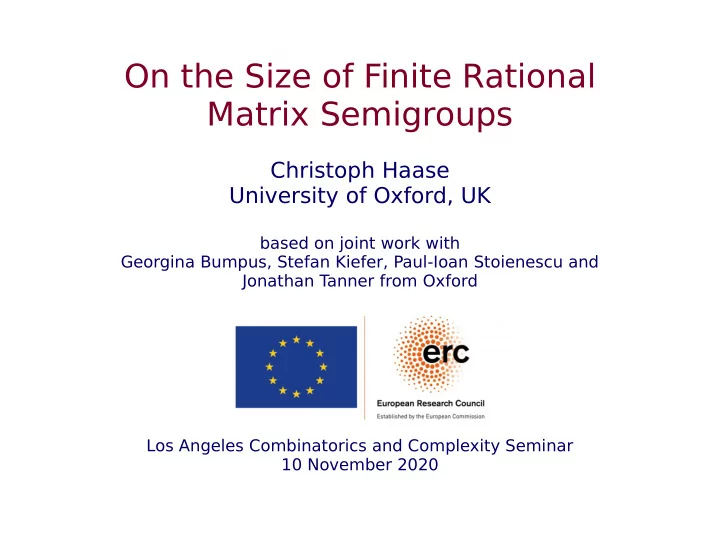

On the Size of Finite Rational Matrix Semigroups Christoph Haase University of Oxford, UK based on joint work with Georgina Bumpus, Stefan Kiefer, Paul-Ioan Stoienescu and Jonathan T anner from Oxford Los Angeles Combinatorics and Complexity Seminar 10 November 2020
Matrix semigroups Given a fjnite set of matrices, denote by the semigroup generated by Examples ● For with have ● For being the set of all (signed) permutation matrices, ● For with have 1
Properties of fjnite matrix semigroups For generating a fjnite semigroup, we are interested in bounding as a function of : ● The length of a given , i.e. the smallest s.t. ● The cardinality of Trivially, a length upper bound implies 2
Motivation from automata theory ● A weighted automaton is a fjnite-state automaton with weights along edges ● Maps a word to value ● Boundedness, is fjnite, reduces to deciding fjniteness of a matrix semigroup 3
Main result Theorem For generating a fjnite semigroup, the length of every is at most order of the largest no dependence fjnite subgroup of on bounded by ● For , Weber and Seidl (1991) give a length bound of ● They also give a lower bound of 4
Size bounds The implied upper bound on is must depend on : No real analogue: Have and hence 5
Complexity considerations ● Size bounds give trivial algorithm for deciding fjniteness of ● Decidability fjrst shown by Mandel and Simon (1977), and Jacob (1977) ● Size bound of Mandel and Simon grows non- elementary for matrices, lower bounded by: ● Our results give a upper bound 6
Finite rational matrix groups Still the group case is much better understood: ● Let be the size of the largest subgroup of ● Elementary proof that ● Friedland (1997), building upon Weisfeiler (1984), established for large enough ● Tight for group of signed permutation matrices ● Feit (unpublished), building upon Weisfeiler (unpublished), showed for 7
Finite rational matrix groups Even though , it is known that: Theorem (Babai, Beals, Rockmore, 1993) Finiteness of a group of matrices given by a list of generators is decidable in deterministic polynomial time. ● Better complexity upper bounds for the semigroup case likely ● No non-trivial complexity lower bounds known for deciding fjniteness in the semigroup case 8
T echniques for the upper bound Our length upper bound for rational matrix semigroups mainly relies on: ● The size bound(s) for the group case ● A graph of vector spaces associated to a generating set introduced by Hrushovski et al. (2017) ● Basic properties of the exterior algebra 9
A graph of vector spaces Given of maximum rank , defjne a directed labeled graph : due to maximum rank have ● and in particular ● For a path of rank with and all in difgerent SCCs, have ● ● for Allows to bound number of SCCs of by 10
Bounding paths in an SCC ● Similar reasoning bounds shortest path between two vertices of as ● Cycles in generate a group ● Rewrite arbitrary path in an SCC as initial segment of cycles and fjnal loop-free path ● Obtain length bound for path in staying in the same SCC of ● Finally consider smaller ranks and combine bounds to obtain overall bound of 11
More on length bounds Deciding is in : ● Almeida and Steinberg (2009) give length bound for the zero matrix ● For , Kiefer and Mascle (2019) give a length bound for the zero matrix, and such that can be computed in polynomial time ● A polynomial upper bound for the zero matrix in the rational case is an open problem 12
Concluding remarks Some open problems: ● Can the size bound be reduced by one exponential? ● Is there a polynomial-time algorithm for deciding fjnitness? ● What is the complexity of the membership problem? 12
Recommend
More recommend